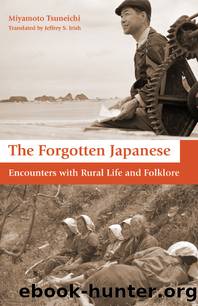The Forgotten Japanese by Tsuneichi Miyamoto Jeffrey Irish

Author:Tsuneichi Miyamoto, Jeffrey Irish [Tsuneichi Miyamoto, Jeffrey Irish]
Language: eng
Format: epub
Tags: Social Science, Ethnic Studies, General, Travel, Asia, East, Japan, Folklore & Mythology
ISBN: 9781611725025
Google: gOLW9efJXqUC
Publisher: Stone Bridge Press
Published: 2010-10-01T03:56:57+00:00
Chapter 10
Literate Transmitters (I): Tanaka Umeji
[1867â1941; Shimane Prefecture, November 1939]
A large, distinct gap can be found between those who were literate and those who were not. Those who didnât know how to read or write took what they had heard at face value and attempted to pass it on without much thought of changing its content. But those who could read and who had access to the written word were able to mix in and pass along knowledge they had acquired through reading in addition to what they had heard. And corrections could be made to information that had been passed down verbally. People had a tendency to believe that âWhat they are saying came from something they read, so itâs reliable.â But if it contradicted what had been transmitted in the village to date, it was rarely adopted by the entire village. As long as a literate individual did not put new information in writing, only those who heard it directly or indirectly from them believed it. Meanwhile the other villagers just remembered the individual as someone who was accomplished.
The literate were extremely sensitive to written stimuli from the outside world. While living the village life, they were forever concerned about the world beyond and were strongly compelled to conform to it. My impressions of one such man, Grandpa Tanaka Umeji, remain vivid to this day.
As I recall, I first learned of Grandpa Tanaka in the spring of 1939, when Kuriyama Kazuo [an ethnologist] showed me a glossary of rice farming in the Ochi District of Shimane Prefecture. Entitled Grains of Hardship, it was written with a brush and in a beautiful hand. Leafing through a few pages I came upon a rice-seedling pulling song.
One person begins to sing: Shall we sing a song?
And everyone else responds: ha-do- nara do- nara
The first person sings: I hesitate to say, but . . .
Then, all together, they sing: I donât know the words to this song . . .
Another person sings: Take that back . . .
The first person responds: I hesitate to say, but . . .
Then, all together, they sing: I donât know the words to this song. . .
In this way, and without stopping, they sing on. A woman with a beautiful voice takes the lead and the others respond.
Thinking, âgoodness, they had big rice planting here,â I read on with great interest. And when I asked Kuriyama-san what kind of person had written this book, he knew only that the author was an old farmer living in the mountains of Shimane. At the time, even in the field of folklore, no study of rice-growing customs was this meticulous. In those days, if you wrote about something in fine detail, you were laughed at and told, âBut arenât those things already completely understood?â For example, an entry in the glossary under the title âOil Peddlerâ read: âAt the time of the big rice planting there are plenty of people, so some men loaf considerably. They stand here and there doing nothing.
Download
This site does not store any files on its server. We only index and link to content provided by other sites. Please contact the content providers to delete copyright contents if any and email us, we'll remove relevant links or contents immediately.
Cecilia; Or, Memoirs of an Heiress — Volume 1 by Fanny Burney(32434)
Cecilia; Or, Memoirs of an Heiress — Volume 2 by Fanny Burney(31868)
Cecilia; Or, Memoirs of an Heiress — Volume 3 by Fanny Burney(31851)
The Great Music City by Andrea Baker(31327)
We're Going to Need More Wine by Gabrielle Union(18967)
All the Missing Girls by Megan Miranda(15560)
Pimp by Iceberg Slim(14377)
Bombshells: Glamour Girls of a Lifetime by Sullivan Steve(13971)
Talking to Strangers by Malcolm Gladwell(13219)
Norse Mythology by Gaiman Neil(13204)
Fifty Shades Freed by E L James(13157)
For the Love of Europe by Rick Steves(12920)
Mindhunter: Inside the FBI's Elite Serial Crime Unit by John E. Douglas & Mark Olshaker(9186)
Crazy Rich Asians by Kevin Kwan(9165)
The Lost Art of Listening by Michael P. Nichols(7403)
Enlightenment Now: The Case for Reason, Science, Humanism, and Progress by Steven Pinker(7228)
The Four Agreements by Don Miguel Ruiz(6618)
Bad Blood by John Carreyrou(6543)
Weapons of Math Destruction by Cathy O'Neil(6139)
